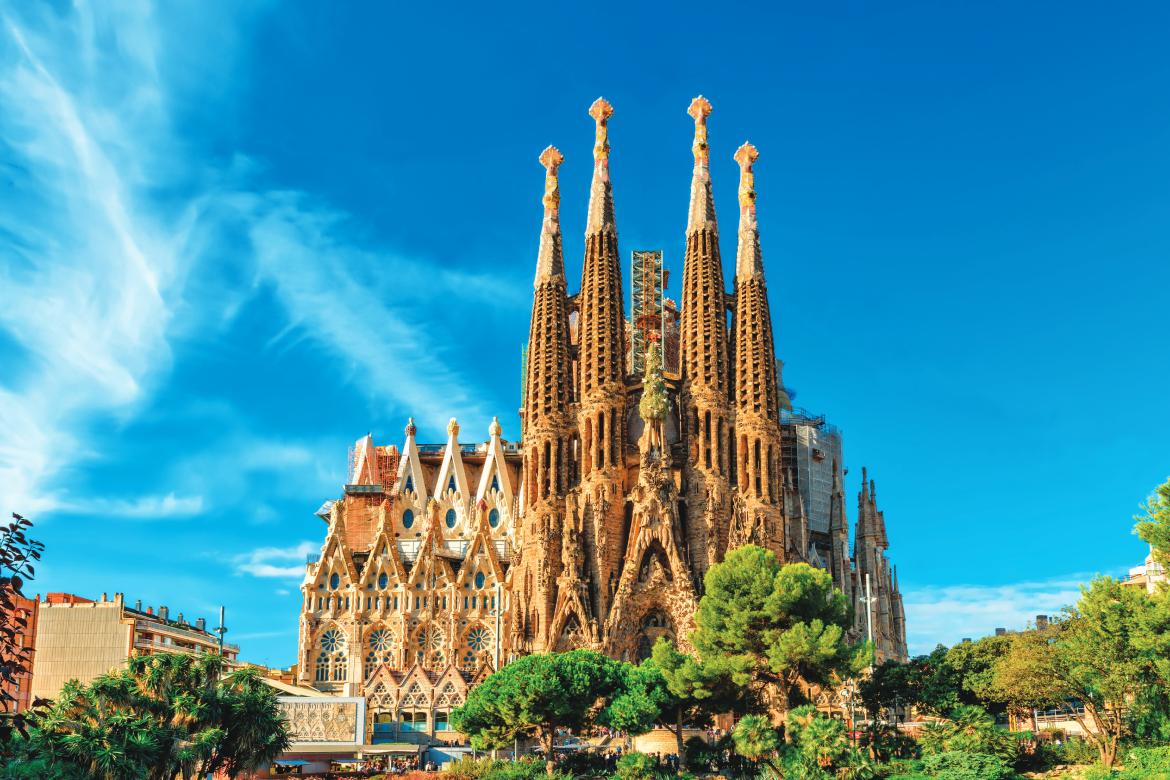It was a brisk evening in Barcelona on the hotel rooftop. Our bottle of cava, two glasses, and a view across the Gothic Quarter felt like the perfect welcome back to the Catalonian capital.
We heard footsteps and laughter rising from the slim streets below. A few blocks away, the ancient spires of the Barcelona Cathedral glowed orange with last daylight, timed with evening church bells ringing softly across the city.
I haven’t stopped dreaming about Barcelona since my first visit there in the mid-aughts. It’s a city made for wandering. Discovery can come in the form of a hidden plaça (town square), tantalizing tapas, herbaceous cocktails, or marvelous architecture—sometimes all in a single stop.
After a long time away, returning to Barcelona felt even more exciting than the first time. On this trip I was joined by my wife, Denise, who lived in Spain for a while and talks like she’s destined to reside there again someday. I’m open to the idea of moving to a Mediterranean city so rich in culture and flavors that only extended time there can satisfy the senses. So we treated this visit like a soft scouting adventure for a potential future home. That approach was a fun way to follow our curiosity and get to know more of the city’s layers, from basic touristic attractions to insider tips.
Our base was in the heart of the city, at the lovely Kimpton Vividora Barcelona (Carrer del Duc, Tel: 34 936 425 400. kimptonvividorahotel.com). The hotel opened in 2020, and after surviving a difficult first year, is now a prime accommodation in the Gothic Quarter. Its historic building gives way to chic design, cozy rooms, and the excellent restaurant Fauna, serving traditional Catalan and Spanish dishes in modern form.
Its street-level café is inviting, but its rooftop Terraza de Vivi is both a brunch spot, and an irresistible open-air bar with a small pool and lounge seating. From this perch, we could soak up the panorama of Barcelona, from sea to hills, and gaze out at tomorrow’s meandering direction. Barcelona is a city with good transit and affordable taxis, but walking leads inevitably to the best finds. Las Ramblas, two blocks from the Vividora, was the natural place to refresh my sense of place on day one.
The big pedestrian promenade is lined with vendors and street performers, with elegant shops and restaurants filling the low-rise buildings at its flanks. Tourists and locals blend together here, taking in sights, sipping coffees, and checking out the strip’s grand old palaces, hotels, and theaters. But it’s the irresistible call of La Boqueria Market (La Rambla 91. boqueria.barcelona) that tempts most people with its fresh delicacies and casual restaurants.
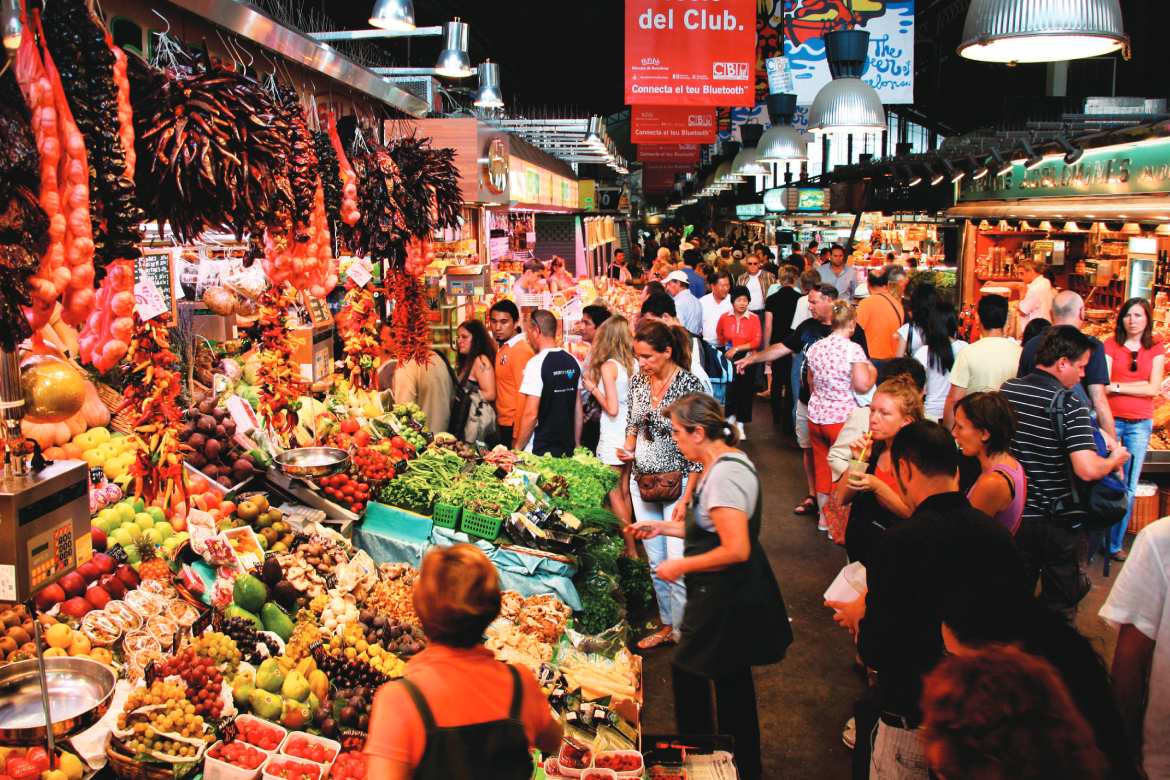
La Boqueria Market (Photo by Tupungato)
La Boqueria serves as a brief lesson in local culture through food and drink, and simply through its name. For English speakers, this is a public market; in Spanish, it’s Mercado de la Boqueria; and in Catalan, the official local language, it’s Mercat de la Boqueria. All three languages are common to see here on signs, maps, and menus. People speak Spanish everywhere, but Catalan is equally common among natives. As a visitor, adding Catalan phrases signals respect for local culture like nothing else. And saying bon dia or bona nit (good morning or good evening), and moltes gràcies (thank you very much) is a reminder that you are in a unique part of Europe, with its own proud, protected regional heritage.
Open since 1836, La Boqueria is a gastronomic adventure that stays busy all day (closed Sundays), selling all manner of groceries, local specialties, and seasonal produce, with stand-up bars around the perimeter for sangria and tapas breaks. Its only downside is its popularity, which I soon learned has grown exponentially since my last visit.
Luckily, another fantastic market just a 10-minute walk away offers much the same enticing gastronomy with far fewer people. Santa Caterina Market (Av. de Francesc Cambó, 16. mercatsantacaterina.com) is where the locals come for their cured meats, cheeses, fresh breads, olives, and so much more, often at stands run by the same families for generations.
To make the most of my time and demands from my true travel boss, my palate, we joined the Devour Tours (devourtours.com) three-hour Tastes & Traditions of Barcelona Food Tour. Santa Caterina was our rallying point, where we began at Bar Joan with little sandwiches (called either bocadillos or entradas), Ibérico ham, sobrassada (spicy sausage), manchego cheese, and the crisp brut cava of Vinya Aderus. It was 11 A.M., and the day was off to delightful start.
From the market, we headed into the heart of El Born, one the oldest neighborhoods, known for its small medieval streets filled with little shops and cafés. What was once a working-class neighborhood is now the city’s hotspot for boutiques, galleries, late-night bars, and some of the best restaurants for any budget. Among the many great finds in El Born, like tiny Bar del Pla (Calle de Montcada 2. Tel: +34-932-683-003. bardelpla.cat) and creative ice-cream shop Gocce di Latte (Pla de Palau 4. Tel: 34-617-986-186), I discovered the spectacular desserts of Pastisseria Brunells (Carrer de la Princesa 22. Tel: 34-936-536-468), occupying the same busy corner since 1852, and still making the best treats and coffee.
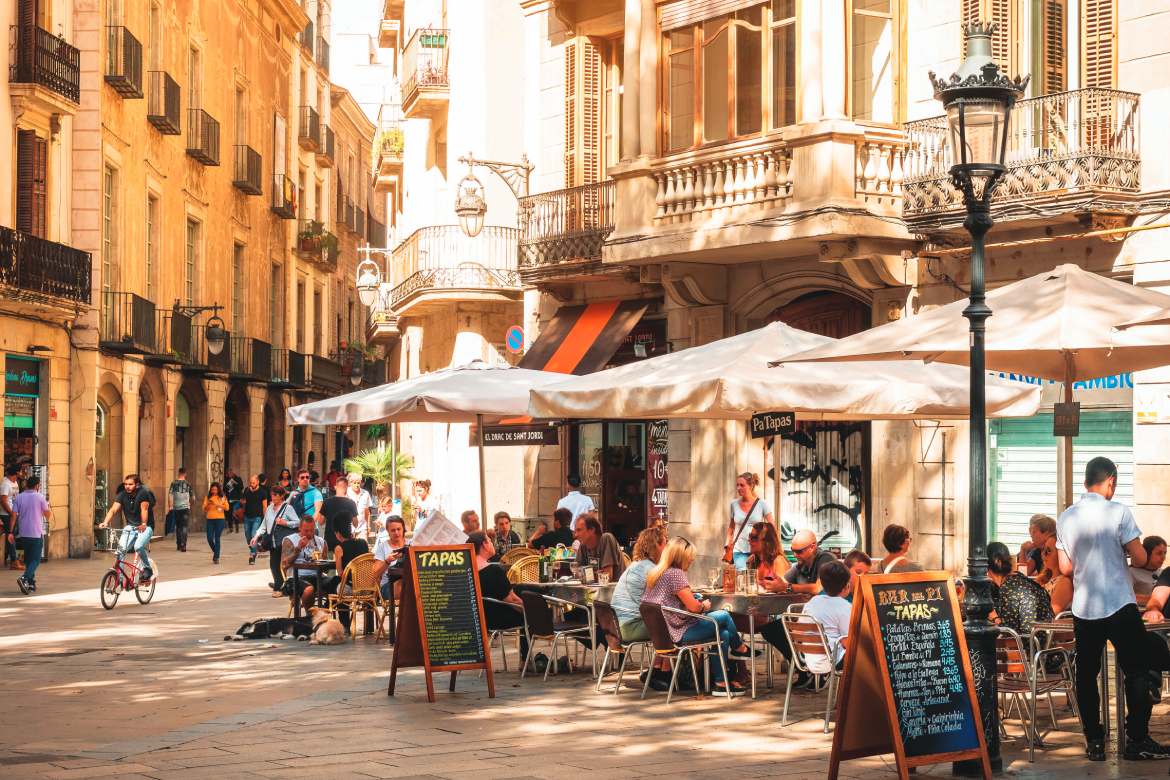
Café and Tapas Bar (Photo by VTT Studio)
Winding past magnificent Santa Maria del Mar church (Plaça de Santa Maria 1. santamariadelmarbarcelona.org), we learned about the evolution of Catalonia culture, and the struggle to maintain Catalan nationality through the centuries. El Born has long been the epicenter of that community, and you can today visit the park that once served as the jousting arena, and the archaeological city ruins housed within El Born Centre de Cultura i Memòria (Plaça Comercial 12. elbornculturaimemoria.barcelona.cat).
Across Plaça de Pau Vila, we entered La Barceloneta, the beachfront neighborhood home to several standout restaurants and bars. One classic Catalan outpost is Can Ramonet (Carrer de la Maquinista 17. Tel: 34-933-193-064. canramonet.es/en), a seafood and tapas restaurant housed in an 18th-century winery. Here’s the place to try traditional local paella made with black rice and cuttlefish. It’s also a laid-back spot to sit at an outdoor table and people watch over the most refreshing and addictive regional staple, red vermouth on ice, served with an orange wedge. We didn’t set out to focus our trip on the El Born neighborhood, yet kept discovering more great ways to spend time there.
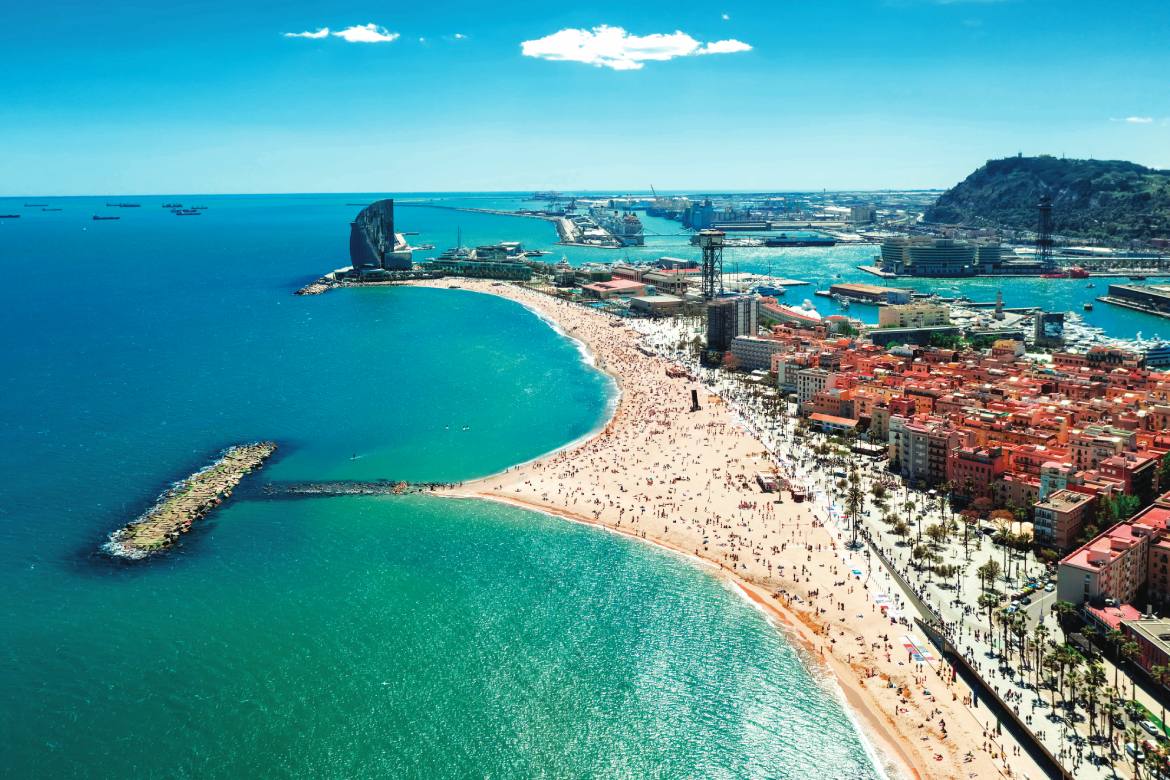
La Barceloneta (Photo by Dmytro Shevchuk)
Barcelona is a city made for wandering. Discovery can come in the form of a hidden plaça (town square), tantalizing tapas, herbaceous cocktails, or marvelous architecture—sometimes all in a single stop.
Among them is one of the best art destinations in town, Moco Museum (Calle de Montcada 25. Tel: 34-936-291-858. mocomuseum.com), a sister institution to Moco Amsterdam. Housed in a 16th century palace, the museum is compact and curated with iconic works by celebrated and rising art stars. It’s an incredible space to appreciate works by Keith Haring, Banksy, JR, KAWS, Kehinde Wiley, Yayoi Kusama, Jean-Michel Basquiat, Andy Warhol, and so many more. Just be sure to buy your ticket in advance and reserve your time slot to avoid a long line.
Following a hot tapas tip from our Fauna restaurant server, we soon found ourselves in the notoriously long line for seat at classic Bar Cañete (Carrer de la Unió 17. Tel: 34-932-703 458. barcanete.com/en) in El Raval. We were assured it was worth the half-hour-ish wait, and yesit was. We pulled up to the long marble bar, studied the busy action swirling around us, and eventually had our charming server/bartender share his top suggestions. From the baby scallops with ham and shrimp torta, to the bomba (potato and meat ball), burratina, and green beans with pine nuts, everything at Cañete felt so right.
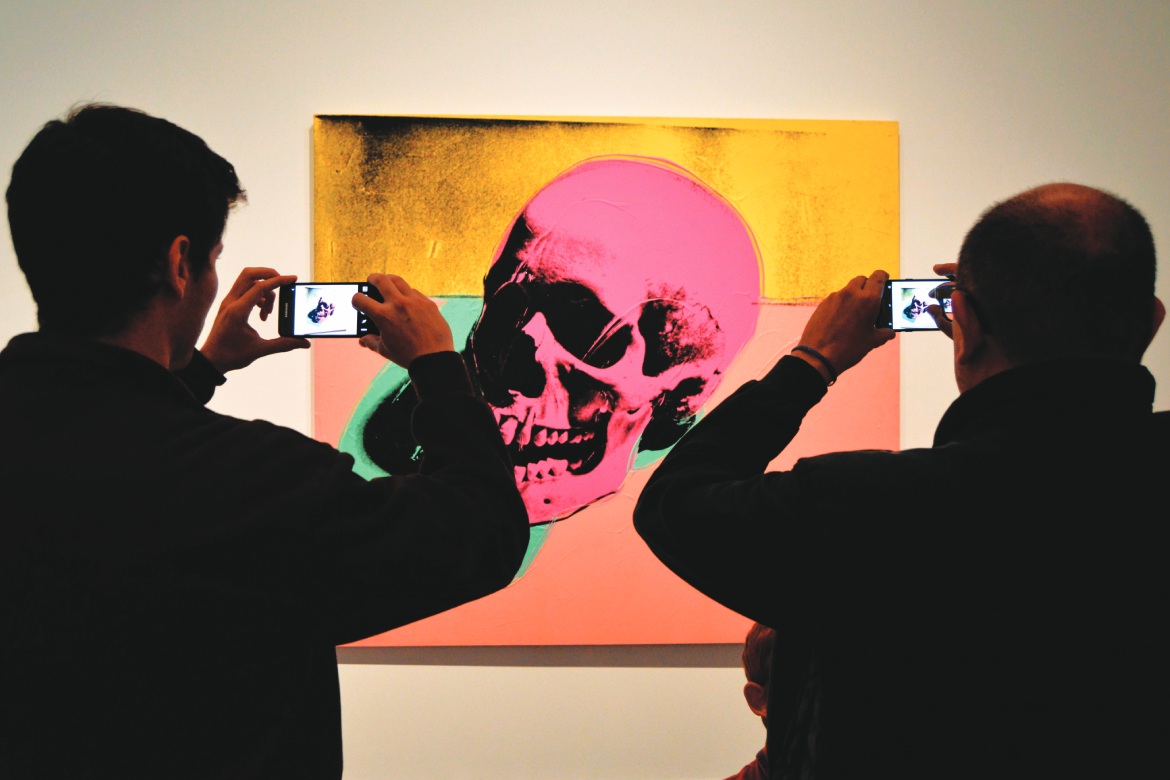
Visitors at Warhol Exhibit in Barcelona (Photo by Giorgiolo)
Barcelona has long been proud of its lively LGBTQ+ community, and while that makes the city fabulous and friendly everywhere, the gay nightlife in town is clustered in and around Eixample (fondly nicknamed Gaixample) in the University of Barcelona’s neighborhood. You could spend numerous nights bar hopping from one rainbow-clad club to another. Many of them open for pre-dinner aperitivo hour, then switch into late-night dance and drag-show scenes. LaCarra BCN (Calle de Muntaner 34. lacarrabcn.com) and Priscilla (Calle del Consell de Cent 273. Tel: 34-679-115-105. priscillacafe.com) are fun flirty bars, and Candy Darling (Gran Via de les Corts Catalanes 586) and Gingin (Calle d’Aribau 40. Tel: 34-679-115-105. gingingaybar.com) get zestier by the hour, usually until at least 3 A.M.
Accommodations are abundant around in the city, but Axel Hotel (Calle d’Aribau 33. Tel: 34-933-239-393. axelhotels.com) offers a suave gay option in Eixample, with a spa, Peruvian-sushi restaurant Nikkei 103, and the sexy rooftop Sky Bar which is open nightly, often with special events.
As our time in Barcelona wound down, we reserved our final day to return to the city’s most marvelous attraction, La Sagrada Familia (Calle de Mallorca, 401. Tel: 34-932-080-414. sagradafamilia.org). We had just visited a few other spectacular works by the Catalan genius architect Antoni Gaudí, including the stunning apartment building La Pedrera-Casa Milà (Pg. de Gràcia 92. Tel: 34-93-142-576. lapedrera.com/en) and mosaic-covered Park Güell (parkguell.barcelona), but we both longed to revisit his masterpiece basilica.
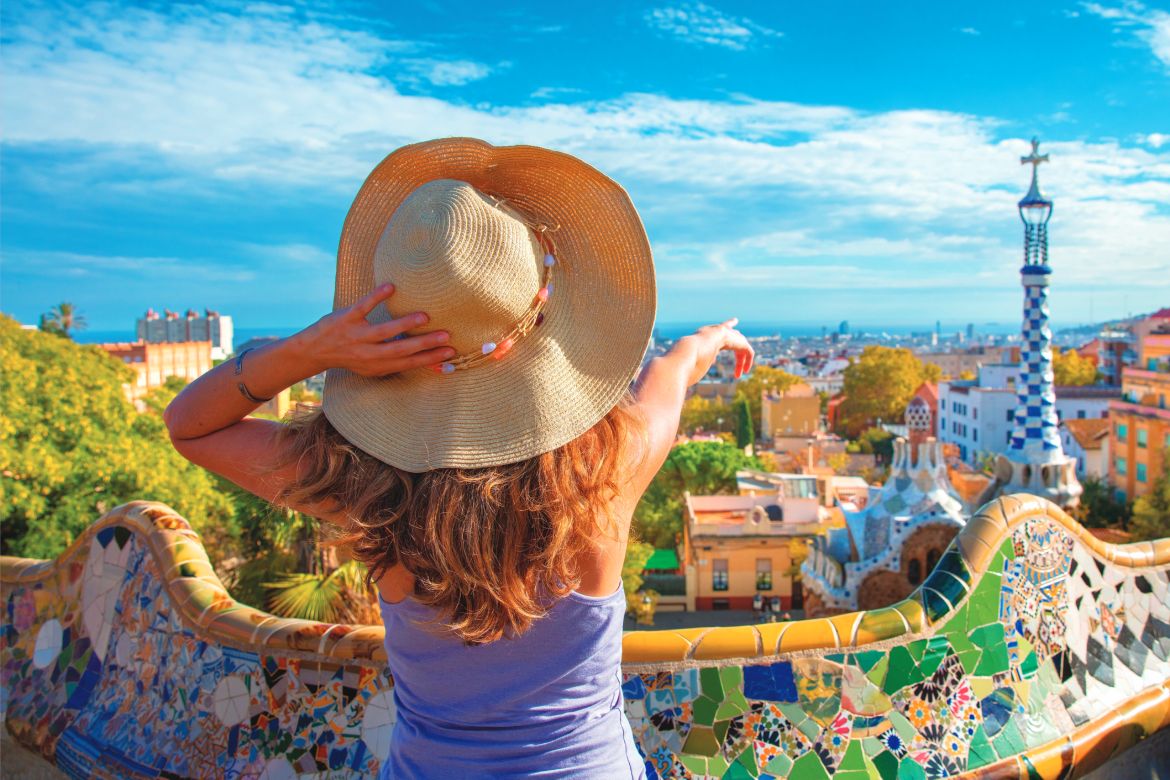
Enjoying The View From Park Güell (Photo by Margouillat Photo)
For two travelers who had last seen the church nearly two decades ago, we can first report that yes, it’s still under construction (since 1882), but it has made notable progress. And it remains one of the most awe-inspiring structures ever built. Its rainbows of stained glass let vivid natural light pour in. Its towering columns stretch tree-like from floor to ceiling as high as 150 feet tall. Its sweeping facades are breathtaking and impossibly rich in detail, sharing the story of the Christ from birth to death and resurrection. And in a humble cellar alcove below the main alter, is Gaudí’s burial tomb. When he died in 1926, he left detailed plans for every element needed to complete the basilica. It’s reassuring to know that a project so grand lives on after its creator’s death.
And it’s reassuring to know that returning to a beloved city can still feel like home, no matter how much time has passed.


